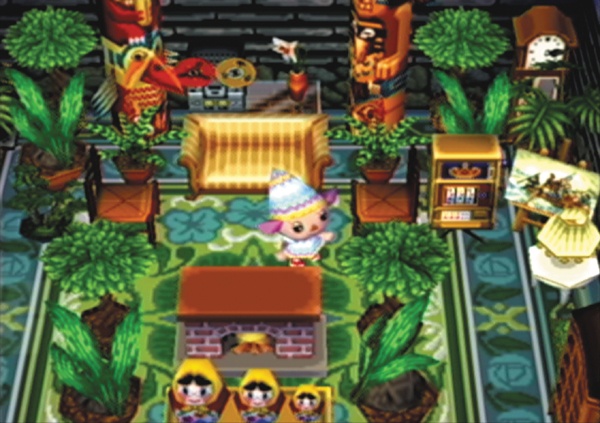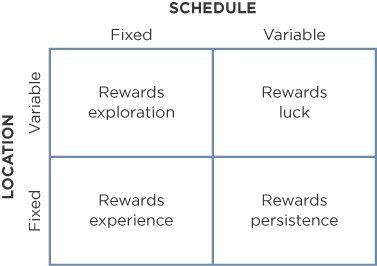Whatever people expect from a game experience, rewards always sweeten the deal. Think of rewards as gifts given to players in recognition of their efforts. Players are your guests, doing you the courtesy of spending time interacting with your creation. Offering something in return can show appreciation for their time while acknowledging their success and acumen. Rewards are worthwhile for two important reasons: they create meaningful measures of the player’s performance, and they help sustain interest in the experience over time.
Even better, rewards in games can be incredibly cheap to make. This is one of the breathtaking efficiencies unique to virtual environments. In the physical world, producing anything carries costs for design, materials, labor, transportation, fuel, storage, and so on. And each item produced can be sold only one time, so a sufficient quantity must be sold to justify their cost.
But in a virtual world, production costs virtually nothing once a reliable system of rewards is set up. Instead of working with real materials, you construct objects out of raw information. A virtual house in FarmVille is nothing more than a few fields in a database and a handful of image assets. Once you have those elements, you can sell the house an infinite number of times. People ascribe real value to it because of its significance to the gameplay.
The value of intangible things is not completely alien to conventional UX design. Users will pay real money for digital greeting cards, desktop wallpaper, and irritating ringtones. But virtual rewards can have much richer meaning in the context of a game world, where they can impart advantages to the player and serve as positive reinforcements for effective play.
There are many well-established ways in which game designers reward players, as well as new and innovative systems that are emerging from the explosive growth of the video game industry. It’s great to have such a variety of rewards, because they each have different effects on players and different advantages for design. Collectively, reward systems make up a tool kit that the designer can use to shape the gameplay experience. This section reviews some of the most frequently used rewards, and explains how you can best put them to use.
One of the most effective ways to reward players for their work is also among the most overlooked. Simple praise for success creates a sense of accomplishment and appeals to players motivated by the need for accomplishment, competence, or even social image (see Chapter 4). Giving players this kind of acknowledgment can promote the sense that they are effective, and that their efforts are worthwhile.
Brain Age, a game for the Nintendo DS handheld gaming system that puts players through a battery of tests of their mental agility, strongly emphasizes praise, which is offered by the disembodied head of a Japanese neurologist (Figure 10-1). As players complete different cognitive exercises, Dr. Ryuta Kawashima comments on how well they’re doing. When players show substantial improvement, his jaw drops and his eyes bulge as he breathlessly showers them with his congratulations. He is designed to provide the payoff that performance-oriented people desire.
Figure 10-1. The ever-supportive Dr. Kawashima is an important part of the player experience of Brain Age.
Frequent praise tied to low-level success conditions can form a kind of positive background tone to a game. Using different tiers of emphasis can also nudge players toward better performance. This approach is common in dancing and music games, which often rate each dance step or guitar strum as “OK,” “Great,” or “Perfect!” Games like Guitar Hero and Rock Band push this positive feedback even further into fantasy with cheering audiences. One of the cleverest features of Nike+ (discussed in more detail in Chapter 11) allows people’s friends to cheer them on while they’re running.
Praise is cheap to implement and easy to apply consistently, and it can be very effective. It’s a great way to start endearing your game to players and shouldn’t be neglected for more complex types of rewards. But praise can accomplish only so much, as it has limited power to compel players to continue the experience for extended periods. It’s also important not to overdo praise, which, if overly fawning, can easily ring insincere.
Points provide a uniform way of ranking separate instances of play relative to one another. They are simultaneously a measure of:
Performance—how well the player has done in this particular sitting
Proficiency—the level of skill obtained through practice
Progress—how far the player has advanced in the game
Point systems appeal strongly to the need for competence because they quantify the overall quality of play and provide an absolute way of knowing whether you’re doing better or worse compared to prior sittings or to other players.
Of course, point systems are not at all uncommon in UX design, where they are used most often as measures of reputation or quality (Figure 10-2). On Ebay, points are used to indicate the reliability of sellers, which can influence a buyer’s decision to place a bid. Amazon and Netflix collect customer ratings and aggregate them into stars and histograms to help people compare different products. Amazon even layers a rating system on top of its rating system by letting users vote for whether a review was helpful or unhelpful. Digg allows users to elevate the visibility of news stories by giving them a thumbs-up or thumbs-down. Connections on LinkedIn serve as an implicit proxy for a person’s professional standing. Likes on Facebook indicate preferences for just about anything.
I want to be careful not to imply that points can or should simply be tacked onto any experience. Points have no value in and of themselves. Rather, they are valuable for the contextual, emotional, and communal effects they can achieve. Both UX design and game design have innovated ways to put point systems to constructive use, creating a great opportunity for each to learn from the practices developed by the other. A few lessons from game design follow.
A key advantage of point systems is that they allow many unrelated types of low-level success to be rolled up into a single, comprehensive number. A platforming game may award points for perfectly executing a jump, successfully dispatching an enemy, picking up coins, finding a secret door, and finishing a level. Though each of these accomplishments speaks to a different skill or element of play, they all translate into the same common reward. In this way, points can simplify play.
Point systems should be applied only in places where they add specific value. If a role-playing game awards points for winning battles but what really matters to the game’s advancement is the level of the player’s character, then there’s not much point in points. If it is a redundant reward, a point system can make the gameplay more complex than it needs to be.
Appropriately varying the number of points given for different actions can give a game greater depth. For example, giving substantially more points for riskier actions can provide an incentive for players to break away from safer habits and test their level of skill. Having a very broad range of points tied to many different types of actions can also support more strategic play, allowing players to pursue high scores in different ways.
Be careful, however, that you don’t inadvertently create ways for players to exploit the point system. Awarding too many points for something can prompt players to pursue that one action to the exception of anything else, making the other elements of the game superfluous. When Harry Potter captures the snitch in Quidditch, so many points are awarded that the other players might as well not have bothered to show up. A game’s point system needs to be carefully balanced through prototyping and playtesting.
You scored 1,529,837 points—WHOOPEE! But wait, how do you know whether that’s good or bad? Points don’t really mean anything if players don’t have some way of comparing them to other instances of play. Leaderboards give points meaning by putting scores in context. They also extend interest in the game by giving players an objective to work toward.
At one level, leaderboards can support players who are trying to improve their game by allowing them to see their personal performance over separate instances of play. Brain Age actually charts players’ progress over time, helping them to visualize how fast they’re improving (or getting worse). Self-tracking extends interest in the game by giving players benchmarks to work toward.
More broadly, leaderboards let players see where they stand relative to other people playing the game. A common mistake in the design of leaderboards is to show only the top 10 or so players. Although restricting the list in this way rightly serves the interests of the people in those 10 slots, it doesn’t let novice players know where they rank in the overall list. Avoid this problem by always automatically showing a logged-in player’s rankings on the leaderboard. You could also divide the list more finely by showing the top performers over different periods (today, this week, this month) or by tracking different attributes (speed, completeness, popularity).
Online leaderboards are wonderfully easy to do in a networked world. They also make compelling social rewards possible by showing players where they stand relative to their specific circle of friends. All the better if you can offer players some means of bragging about their performance.
Like points, currencies can be awarded in exchange for small wins throughout the session of play. They also similarly appeal to the players’ need to feel competent by recognizing their skill. But currencies differ from points in that they both grow over time and can also be spent in various ways to benefit the player in the game. So currencies are an embedded element of the gameplay itself.
It’s useful to group currencies by two major types. General currencies work just like money in the real world; they can be spent on anything. They may give the player access to new kinds of weapons, properties, clothing, decorations, and so on. In multiplayer experiences, people can exchange money with one another for services or as bribes. The monetary systems of some modern online multiplayer games have grown into robust economies in their own right. In EVE Online, for example, goods in the game are priced by supply and demand.
In contrast, specialized currencies may be spent only on specific things. Specialized currencies are very common in role-playing games, which allow players to build characters around preferred attributes. Players may earn experience points or even more specialized currencies, such as intelligence points or cooking skill points. Players can then choose to spend these points on attributes like speed, strength, dexterity, magic power, or Thai cuisine. In this way, players can adapt the gameplay experience to suit the way they prefer to play. This approach appeals to players whose motivations lean toward autonomy.
Game currencies create a more engaging experience by forcing players to make decisions about how their earnings can best be applied. So the scarcity of the currency is important; its availability must be balanced against the cost of the things on which it can be spent. The player is then forced to make trade-offs among the available options. As discussed in Chapter 3, a great way to make games more interesting is to ask the player to make meaningful choices.
Scarcity also compels players to do the things the game asks them to do. If it were too easy to make money, the currency system would lose its challenge and the work of the game would become pointless. Suppose a role-playing game contained dungeons full of enemies, each of which paid anywhere between 1 and 20 gold pieces when it was defeated; but right outside of the dungeon there was a magic fountain that paid players 60 gold pieces a minute simply for standing next to it. Why would anyone then choose to go through the dungeon? Striking it rich may have its perks, but it undercuts the appeal of good hard work.
Games often present players with simple, highly visible meters that keep people aware of the scarcity of vital currencies. Forgive a quick digression: I’ve often thought that my life would benefit from having similar visualizations of the scarcity of time or money. It couldn’t be that complicated for Microsoft Outlook to calculate the amount of time I have outside of scheduled meetings before the end of the day and present it as something akin to a health bar, right there on my desktop (Figure 10-3).
If you’re trying to decide whether your game should have a point system or a currency system, there are two other factors you should weigh. First, currencies pose a much larger design challenge than do simple points. With currency systems, you need to plan for additional overhead to brainstorm items that can be purchased, assign attributes to them, design image assets for them, balance them, test them, and price them appropriately.
Second, currencies are generally better suited to games played over an extended period and in situations that allow players to save their work. The ability to pick up where you left off and build off of prior success certainly enhances the value of the currency. Point systems work perfectly well with game experiences that can be completed in a single sitting.
Many games organize the development of a player’s character into levels. These are stepped plateaus that the player ascends over the course of the game by completing required tasks. The player typically earns some form of points each time a task is completed, and the character is promoted to the next level when enough points have been accumulated. At each advance to the next level, the character’s attributes are enhanced in some way. Think of the programs run by financial institutions that give lower fees and greater privileges to customers who hold progressively higher minimum balances. (Think, too, about how such programs might benefit from the design practices pioneered by game designers, to be described shortly.)
Leveling gives the player a sense of growing personal power. Over time, the character will journey from a nearly powerless role to a dominant one. Things that were once very difficult to do will become much easier, and the player will be ready to surmount new kinds of challenges. Leveling appeals to motivations of catharsis, accomplishment, and competence.
Leveling can benefit a game’s design by giving structure to the gameplay and by providing players with a basis for understanding their progress through that structure. Designers can take advantage of these benefits by relating events in the game to the character’s level.
Games’ leveling systems typically contain some challenges that simply aren’t attainable by players at lower levels. There are two common ways of making certain challenges available to only some players. First, designers can hard-code a minimum required level to perform an action. For example, a fantasy-adventure game might allow only a level-20 mage or higher to wield a golden scepter, which is itself necessary to gain access to the castle tower. Alternatively, progress may just be prohibitively difficult for characters with lesser attributes, as when a castle is guarded by a troll whose attributes are so strong that it makes swift work of any player below level 17. Either approach is helpful for design because it can create structure across the entire game environment, allowing the chapters of the game to unfold progressively.
Leveling systems represent a variation on schedules of reinforcement beyond those defined by Skinner (see Chapter 9). Players are on a fixed schedule, in that the point at which they reach the next level is predetermined and knowable. But the schedule isn’t fixed either by ratio or by interval. Instead, players are aware of the number of experience points they need to reach the next level. The result is a behavior pattern similar to that of a fixed-interval schedule, in which players work harder when they know they’re close to reaching the next level.[36]
Designers can enhance the “stickiness” of a leveling system in two ways. First, players need to feel that the next level is attainable. If the levels are too widely spaced, then players will start to give up (extinction). Successful games typically contain dozens of levels, and dedicated players can often get through at least one in a single sitting. Second, players must feel that the effort is worthwhile. Upon reaching a new level, the enhancement made to a player’s character should be significant enough that the difference is noticeable. The enhancement can be slight, but the player should have some sense that things have improved.
Levels can help extend interest in the game far beyond the amount of time players would have otherwise spent playing. Many games require players to repeat similar actions over and over to gain enough experience points to reach the next level. This is a sneaky way of artificially turning less game into a longer gameplay experience. Without the clear objective provided by the leveling system, players would have no reason to fight the same orcs or gelatinous cubes over and over again. Of course, there’s a limit to a player’s tolerance for repetition. But well-designed levels can lighten the burden on design and development by getting more use out of the game’s assets.
The ability to acquire and customize virtual possessions has become a common feature in modern video games. Clearly, the ability to customize virtual possessions appeals strongly to the need for creativity. But it also promotes a sense of investment within the game world, giving players something uniquely their own. In addition, customization offers social rewards by allowing players to showcase their work, enabling self-expression.
A customization dynamic can be incorporated at many different levels of the game’s design:
The physical appearance of the player’s avatar. Miis, for example, are part of the unique charm of the Nintendo Wii’s user interface (Figure 10-4).
The avatar’s clothing, jewelry, and hairstyle (Figure 10-5). Similarly, many racing games allow players to customize their cars with paint, decals, rims, and other bling.
Construction of the avatar’s home. The Sims provides a very open building interface that allows players to decide where each wall should be to create a home’s living spaces (Figure 10-6).
Decoration of the avatar’s home. Animal Crossing provides players with a vast number of home decorations, from area rugs to jukeboxes to video game systems (Figure 10-7). Functional decorations that play music or cook food add further appeal to customization.
The game itself. Some games provide players with a level editor. LittleBigPlanet lets players create and share their own fully fledged video games using a simple but comprehensive set of editor controls (Figure 10-8).
Customization serves as a reward when it’s tied to a monetary system in the game. As players earn more money, they can afford increasingly expensive goods. Offering items in a broad range of price points encourages players to set objectives, dedicate themselves to the work of the game, and smoothly ascend a continuous grade to greater and greater prosperity. This steady, gradual climb contrasts with the stepped structure of a leveling system (Figure 10-9), and it gives the player greater control over the experience.
Customization options offer a much bigger payoff when players have the opportunity to share their creations online with one another. FarmVille encourages players to invite their friends to play the game, and then situates their farms adjacent to each other. Some players construct elaborate and sprawling estates, inspiring other players and giving them a reason to engage with the game (Figure 10-10).
One of the best-established video game patterns is a play area peppered with assorted health packs, weapons, and other items that give players new capabilities. Although such item drops may not be very realistic, they are an effective way to shape player behavior while adding interest to the gameplay experience.
Item drops can affect the way players experience the game in several ways:
They may be used to lure players into taking greater risks. In a racing game, a particularly desirable power-up may be placed right on the edge of a cliff. Such a design creates a meaningful choice for players, forcing them to evaluate their own skill and weigh the benefits of success against the consequences of failure.
They can provide hints or encourage players to discover new areas in the game. Being able to see an item is a cue to the player that there must be some way of getting to it even if that path isn’t immediately apparent. The effort needed to reach the item can deepen the player’s interest in the game.
They can foster competition in multiplayer games by giving people something to fight over. In this way, the items reward players both for their skill and for their familiarity with the game.
They can enable strategic play. The game may be balanced in such a way that players gain different advantages by chasing specific types of items. For example, some players in a multiplayer shooter may favor picking up invisibility power-ups, whereas others may seek out more powerful weapons to improve their offense or pick up armor for defense. In each case, the experience of the game might be very different.
Items may be programmed to appear again and again in the game environment. Where and when the drops occur further alter the gameplay. As shown in Figure 10-11, different types of locations and schedules may be combined to produce different effects in the game.
Fixed locations with fixed schedules reward the players who are most familiar with the game. Experienced players will start hanging out at the known drop locations right around the scheduled drop time.
Fixed locations with variable schedules reward persistence. The uncertainty about when an item will appear encourages players to revisit the same spot frequently.
Variable locations with fixed schedules reward exploration. When players know that the right amount of time has passed, they will begin to check different likely places.
Variable locations with variable schedules don’t reward any particular behavior. This combination brings a stronger element of luck into the game, which favors both experienced and inexperienced players equally.
As the game designer, you can add another twist to the gameplay by varying the types of items that appear at the drop location, themselves on either a fixed or variable rotation.
Some items may provide players with a tangible benefit. A positive reinforcement will give the player something desirable, such as a speed boost in a racing game or a powerful weapon in a shooter. A negative reward will temporarily alleviate something undesirable from the gameplay. For example, the star in Mario Kart makes players temporarily impervious to attacks.
Dropped items might also punish players who carelessly pick them up. Punishments can be very effective in racing games, where players’ momentum may carry them into an item even though they’re trying to avoid it. Punishments may also be positive, as with a bomb that inflicts direct damage; or negative, as with a flat tire that robs players of speed.
Many popular games challenge players to collect items from a fixed available set, which are retained in the player’s inventory rather than being spent or lost. Collectible items have a specialness that stands apart from the appeal of points, currencies, or item drops.
Collection systems take advantage of a natural human inclination to find, capture, and hold on to things. My first job out of graduate school was at the Web agency iXL Enterprises, which had a unique recognition program that gave one of three awards, each representing a letter in the company’s name. The “i” award was given for innovation; the “X” award was given for extra effort; and the “L” award was given for leadership. Each came with a trophy for the letter, and the three trophies snapped together to form the complete logo. Some people were highly motivated to collect all three, and in pursuing them they worked in ways that the company valued. Where some people are driven to collect interlocking trophies, others are drawn to stamps or coins. The desires for symmetry and completion can make collections powerful motivators.
As a game designer, you can capitalize on people’s inclination to collect by structuring challenges around the promise of acquiring more stuff. Broadly, there are three ways that collectible items may be acquired in a game:
Earned items are awarded when the player accomplishes something in the game. This is an easy way to motivate players to take on a game’s challenges. Pokémon, for example, requires players to win fights to fill out their collection of brightly colored monsters.
Found items require the player to go on a kind of Easter egg hunt through the game environment to find the hidden items. This design encourages exploration, which works well in expansive game worlds. The Grand Theft Auto games, for example, contain multiple collection systems requiring players to steal certain cars, find hidden packages of drugs, and paint over gang graffiti. Players who take on these optional challenges discover the impressive size of the virtual environment.
Purchased items combine a collection system with a currency system to create an even more compelling reward system. The advantage of using game money to acquire collectible items is that many different types of actions—fighting, working, trading—can be translated into ownership of the items.
A collection system’s capacity to hold players’ interest in the game is a function of the size of the collection and of the difficulty of acquiring the collectible items.
An entire set of collectibles commonly comprises dozens or even hundreds of items. Because such large collections are very conventional, you shouldn’t be too concerned about overdoing it. Besides, a large collection allows players to collect until their interest in it naturally expires, instead of being cut off early. However, if the size of the collection is so vast as to seem unattainable, then players may start to wonder whether they should even bother trying.
Most games that include collection systems provide a range of difficulties for acquiring items. It’s beneficial to have a large number of items that can be acquired quite easily. Quickly finding a number of items gives players the sense that collecting is an attainable and worthwhile objective, while providing them a taste of the collection dynamic. Gradually increasing the difficulty to the point where a few items are very hard to obtain allows the collection dynamic to naturally keep pace with the player’s growing skill and familiarity with the game environment.
Achievements are one of the newer developments in game design and have exploded in popularity in recent years to become one of the most recognizable conventions in contemporary gaming. Achievements form a kind of metagame that rides on top of the formal game experience. They invite the player to dive very deeply into the gameplay and perform difficult or unusual things just for the sake of having done them. They take advantage of the drive that inspires some people to climb mountains, appealing strongly to the motivation of accomplishment.
A major design advantage of achievements is that they can be awarded for absolutely anything. You name it: Escaping the enemy compound without killing anyone. Causing a pileup involving at least 10 cars. Collecting every coin in a particular level. Anything that can actually happen in the game can make for a good achievement. This flexibility allows designers to reward players for taking a very active interest in the game, and pursuing achievements lets players gain an appreciation for the extent of the game design.
Achievements involve very little design overhead. They ask the player to perform something that could be done in the game anyway but might not otherwise be necessary. They may, for example, ask the player to complete a level without using any health packs. Nothing in the game design prevents the player from attempting to do that, but without the achievement as a motivator, the player would have had no reason to try it.
So the game itself can remain exactly the way it is without any special accommodation to support achievements. The only development costs are in creating sniffer programs to detect when the player has met the requirements of each achievement, in alerting the player, and in designing an interface that displays the achievements.
Because achievements are so cheap and easy to create, many games offer dozens of them. That’s great, because then designers can accommodate a broad range of player skill levels, from complete novice to seasoned master. As a result, more players can feel like beneficiaries of the reward system, which can make the game feel accessible.
Challenge is good for players who really want to be tested, but make sure you never ask the impossible. Always test your achievements to be certain that the thing the player is required to do can actually be done. Sending someone off to pursue something that’s impossible is a special kind of cruelty.
Known versus Hidden Objectives
Achievement systems vary by whether or not they tell the player what’s required of them. Each approach offers different advantages.
Known objectives keep players moving forward by always providing achievements that people can work toward. If you’re concerned about drop-off in play, consider achievements with known objectives.
Hidden objectives don’t tell players exactly what they need to do to get the achievement. Sometimes a clue might be provided, such as the name of the achievement without its description. Players need to make some guesses about which things will score them an achievement, which may or may not pay off. Hidden objectives reward self-motivated interest in the game.
Clearly it’s important that achievements with hidden objectives be somewhat intuitive and be awarded for logical challenges in the game. But they can also pay off in their surprise. Animal Crossing awards an achievement for standing completely still for five minutes. At some point in time, most players will set the controller down while they attend to something else, only to be delighted to find their inactivity rewarded.
Sometimes you may want to reward players with something more substantive to recognize their accomplishments. One approach is to allow players to unlock special content that otherwise remains unavailable to them.
Just about anything you design in the game that isn’t essential to the core gameplay can be turned into unlockable content, and the actions that players have to complete to unlock them can be as flexible as those for achievements.
Advanced gameplay modes are a common form of unlockable content. These are harder levels that are unlocked once the player completes the game on an easier setting. When players start a game in Halo, they can see that a mode called “Legendary” exists, described tauntingly in this way:
You face opponents who have never known defeat, who laugh in alien tongues at your efforts to survive. This is suicide.
But players can’t access the Legendary mode until they complete the normal difficulty level. This is a smart approach because it gives players access to the harder mode only when they’re ready for it. This kind of unlockable content can significantly extend players’ time in the game by appealing to their need to feel competent.
Other games allow players to unlock more parts of the story line as they progress through the game. Fighting games like Tekken often play a cinematic cutscene each time the player successfully completes the game with one of the characters, filling in that character’s backstory. After they’re unlocked, players can access the cutscenes again at any time through a cinema library. Narrative elements like these build the richness of the game world, prioritizing the player’s need for immersion. But it also parcels out the narrative in small doses, asking something of the player first.
Unlockables can substantially benefit the design by giving players something to work toward. The major disadvantage of unlockables is that they deliberately make a portion of the game unavailable to the player. So the effort that went into developing the special content will be wasted on those players who don’t manage (or care) to unlock them. As the game designer, you should carefully weigh the cost of creating content against the probability that players will actually experience it.
You can maximize the cost-benefit ratio of locked content in a few ways:
Make sure players are aware that the unlockable content is available. Whet their appetite with teasers or empty libraries from which the content will be accessed.
Control the difficulty of the tasks players need to complete to unlock the content. If the tasks are too challenging, players might feel discouraged and decide not to try.
Conduct playtesting to make sure that a sufficient proportion of players will actually feel motivated to try to unlock the content and will have the ability to do so.
Some rewards exist outside of the game world altogether and are instead about the experience of playing the game.
The first “Easter egg”—a secret hidden inside the interface—was a developer credit screen in the 1975 game Adventure for the Atari 2600. Easter eggs are a wink to the player from the people who made the game. They reward players for taking an active interest in the game and exploring its environment. People don’t know that the Easter eggs are there, but rather stumble across them. Because there can be no active effort to locate Easter eggs, they can’t be used to motivate players to take certain actions.
Easter eggs can, however, reward players by delighting them with an unexpected surprise, especially when players have just had to do something elaborate or challenging. There’s an area in the middle of the virtual city in Grand Theft Auto III that is surrounded by high walls with no steps or ladders nearby. Players can reach the area only by parking cars of different heights along the wall, climbing up from one to the next, and then jumping to the other side. The player then turns around to see a message written on the wall: “You weren’t supposed to be able to get here you know.”
Many game designers deliberately build in cheat codes, in which the player executes improbable button presses that change the conditions inside the game. Cheats may, for example, instantly give the player all the weapons in the game, restore all health, grant invincibility, or bestow other favorable shortcuts to regular play.
But is cheating okay? Wouldn’t allowing cheating be ethically dubious? Wouldn’t it undermine your game’s carefully balanced design? Perhaps surprisingly, some game theorists urge designers to have sympathy for the cheater.[37] After all, people cheat because they want to improve their experience of the game. In a way, they’re showing that they value the game’s outcome; they’re just dissatisfied with the conditions for success that the design places on them.
Building cheat codes into a game rewards players for taking an interest in it. Of course, doing so sacrifices the designer’s intended experience. But when players are willing to cheat rather than deal with the obstacles you’ve created for them, this might be the better trade-off. Players might otherwise decide to bail on the game altogether, so cheats can give you a second chance to keep them inside the experience.
In addition, no one gets hurt if the player is only cheating the computer running the game. The circuits will take no offense and will hardly notice the injustice they’ve suffered. Still, there are two situations when cheating does become a real problem. In the first case, other real people are the victims of the cheater. If there’s a multiplayer aspect to your game, allowing players to cheat destroys the experience for everyone else. In the second case, the game pays out some kind of reward in the real world, which is the subject of the next section.
Some games go a step further and offer players tangible rewards such as money, prizes, or special privileges. Such external rewards offer players something beyond the joys that are to be found within the game itself.
A clear disadvantage to this approach is that it requires someone to lay out additional money. However, designers can mitigate this drawback by paying out rewards that defray their own expense. Coupons, for example, can drive business by bringing new customers into stores.
External rewards also can’t make up for the shortcomings of a lousy game. In the early 1990s, a video game called Treasure Quest lured players in with the promise of a $1 million prize to the first person to correctly solve all of its puzzles. The experience of playing through the game’s bizarre and incomprehensible interface, however, was miserable. Treasure Quest has long since been forgotten, and the experiment has not been repeated.
But there’s another, more subtle risk to offering players external rewards. Significant research since the 1960s has shown that in the real world, such rewards produce actions that are of lower quality: less creative, less thoughtful, and less accurate. The reason is that these external rewards have no effect on people’s underlying motivations to take action in the first place; the reward is sought only for the sake of the reward. There is no improved regard for the activity itself.[38]
I must mention that this research also implicates praise, point systems, collections, and other rewards like those that I’ve already discussed. But I would argue that it doesn’t apply to the game world, because the game world is an imaginary space that players willingly enter girded with unalloyed motivation to enjoy intangible success. These rewards must be understood as a part of the gameplay experience itself, since they have no tangible manifestation beyond its boundaries. Only when rewards regress outward from the game’s magic circle into the real world do they become problematic, because the prospect of a real payoff can overshadow the intrinsic delights of engaging with the game. The gameplay can then come to be seen as drudgery standing in the way of the player’s real goal. This effect is destructive to the experience, and a real problem for design.
The video game industry has proven to be fantastically successful without offering players anything tangible in return. That’s because the act of playing a good game is itself inherently enjoyable. Intrinsic rewards have such demonstrated success that they are pervasive in game design. If all you offer as a reason to play is external rewards, then what you’re left with is something closer to an incentives program.
Nonetheless, I would stop short of completely ruling out a role for external rewards in game design. Clearly, such rewards work for roulette, lotteries, and game shows. But for the reasons I’ve discussed, they can also cheapen the gameplay experience. Any decision to implement a system of external rewards should be taken with full awareness of this risk. If you do choose to offer an external reward—say, to spark interest in your game—you’ll be most successful if you rely on more captivating intrinsic reasons to keep people playing.
When you’re designing a game, one of the first things you should consider is how long you expect people to play it. Many short game experiences need only a single reward system. Pong has no game currency, no levels, no power-ups, no clothing options, no Easter eggs, no cheat codes—and it offers very little in the way of story line (line hits dot, dot flies into hole). Points alone are quite sufficient for Pong.
On the other hand, people don’t play Pong all that long. Modern games can last weeks or months, and over that kind of time frame you need much more to keep things interesting. That’s why many games today incorporate multiple reward systems into the experience. Grand Theft Auto, for example, uses nearly all of the reward systems described in this chapter. Players who grow bored with the story line can turn their focus to earning money, tracking down hidden items, customizing their characters’ hair and clothing, or filling out their collections of achievements.
Games sometimes nest their reward systems so that players need to obtain one reward to gain access to another one. In Final Fantasy, the money that players earn from battles allows them to purchase better armor and weapons, which enable them to win more battles, which allows them to level up their characters, which unlocks the story line.
Size your reward systems appropriately for the ambition of your design. More rewards mean that more time and effort are required to plan, balance, and implement them, but well-executed rewards can pay you back immeasurably in the quality of the gameplay experience.
[36] Von Ahn, L., & Dabbish, L. (2008, August). General techniques for designing games with a purpose. Communications of the ACM, 51(8), 63.
[37] Salen, K., & Zimmerman, E. (2004). Rules of play: Game design fundamentals. Cambridge, MA: MIT Press, p. 275.
[38] Kohn, A. (1993). Punished by rewards. Boston, MA: Houghton Mifflin, pp. 35–48.











